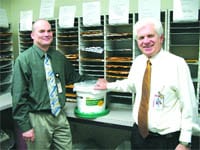Progress in Bloom Green Ideas Take Root at Local Hospitals
As the benefits — both financial and ecological — of ‘green’ thinking sweep the business world, health care has taken a major role in the shift. Locally, hospitals are casting an earth-friendly eye toward how they power their facilities, what supplies and chemicals they use to sanitize rooms, how they dispose of waste, and any number of other daily jobs. Hospital administrators say the public, particularly in progressive Western Mass., expects large institutions of all kinds to be aware of the footprint they cast on their environment. They say such changes can be good for patients’ health — but also realize that going green can benefit the bottom line. Here’s a look at what area hospitals are doing in the ‘green’ realm.
Mercy Medical Center: No Trash Left Behind
Hospitals have always produced a lot of trash. But they don’t have to discard all of it into landfills — especially considering that every ton of paper that goes unrecycled costs the planet one mature tree.
“By recycling paper, we save 357 trees a year,” said Stan Rogalski, vice president of System Support Services at Mercy Medical Center. But that’s not all. “We recycle cardboard — eight tons of it a month. And all our batteries get recycled; we have buckets set out for employees, and once a bucket gets filled, we ship it to a company that recycles batteries. All of our toners and printing cartridges get recycled, too.”
The list goes on: Mercy also has an oil-recovery program by which all the lubricating oil used in machinery gets picked up and reprocessed, and its used cooking oil is set aside for use in automobiles. Old computers and monitors are sent to a company for refurbishment or proper disposal, and scrap metal is recycled. Meanwhile, any sterile surgical implements unsealed but unused in the operating room go through a process sanctioned by the U.S. Food and Drug Administration to be reprocessed and resterilized.
In short, there’s hardly any waste that Mercy doesn’t try to find a better way to discard. That’s no accident; the hospital has a green team that meets monthly and related subcommittees that gather every two weeks. “The green team is a group of employees from all parts of the system,” said Jon Cooney, manager of Building Services at Mercy. “They volunteer their lunch hour and talk about what we’re doing, what we can do better, and how we can change in the future — what are other things we can get on board with?”
Rogalski said ecological awareness, reflected in the recycling efforts, are just another part of Mercy’s responsibility to be a good citizen. “We’re a mission-driven organization, and part of our mission is to be good stewards of our resources, so that’s what we try to do,” he explained.
Cooney said that, while Massachusetts is starting to implement waste bans, Mercy has developed a culture that won’t have to adjust much to meet any new law governing trash disposal and recycling. “We were doing many of these things even before the green movement became trendy,” he said. “The cardboard recycling is one thing we’ve been doing for the past 10 years.”
Dedicating a committee to environmental efforts has led to other changes in the Mercy culture as well, said Rogalski, such as burning natural gas or low-sulfur fuel, composting grass clippings, and using cleaning chemicals that are certified through Green Seal, a national nonprofit organization that promotes non-toxic agents that break down in nature quickly.
“The only piece that’s not ‘green’ is the germicide itself, which is by nature a pesticide, and we have to meet health and safety regulations,” Rogalski said. “But there are a few companies that are in the process of developing germicides that are both able to disinfect areas properly and meet environmental standards, and that’s obviously something we want to be involved with.”
Sounds like a great lunchtime chat.
Holyoke Medical Center: Neutralizing Mercury
Sharon Flynn says some Americans are old enough to remember handling mercury in science class. “But we know now, obviously, that mercury is extremely toxic and hazardous.”
It’s also a fairly common substance in hospitals; mercury has long been a mainstay of medical devices, not only in the readouts on thermometers, but also in the gauges on blood-pressure cuffs, as well as some feeding tubes and catheters. And occasionally, those devices break, and mercury spills out. The question is, what to do with the spill?
“Years ago, when there was a mercury spill, it was just disposed of in the regular waste stream,” said Flynn, director of Materials Management at Holyoke Medical Center. “We started looking at how much mercury we have in here, and we decided as a hospital to protect the environment and the safety of patients by disposing of it properly.
“There isn’t any law in Massachusetts requiring hospitals to remove mercury from the workplace in a specific way,” she added, “but we thought it would benefit everyone if we were proactive in solving this challenge.”
Now, when a spill occurs, the hospital sets in motion a specific hazardous-materials procedure and calls in an environmental services supervisor, while regular staff are cleared from the immediate area. The accident is handled (by staffers wearing gloves and eyeguards) with a mercury-specific spill kit, which includes a substance that, when sprinkled over the mercury, helps to solidify it, making it easier to pick up and place into a plastic bag.
From there, the mercury is taken to the HMC laboratory; the hospital contracts with a company called Clean Harbors to pick it up from the lab and dispose of it according to federal laws.
Mercury exposure is a serious matter; while inhalation can cause severe respiratory damage and skin contact can cause irritation and worse, chronic occupational exposure can bring about a host of problems, from muscle tremors, personality changes, and memory loss to loosening of the teeth, digestive disorders, skin rashes, brain damage, and kidney damage.
Flynn knows Holyoke isn’t alone in being more diligent about proper mercury disposal — “I don’t think anyone is intentionally putting mercury into the waste stream rather than disposing of it properly,” she said — but believes every small step like this one contributes to a growing culture of environmental awareness.
“I think people are becoming more responsible about these things,” she said. “It’s both good business practice and good environmental stewardship. We’re committed to both, and we’re proud of that.”
They’re also encountering fewer opportunities to spill mercury. Most hospital thermometers are of the digital variety; at HMC, only rectal units still use the liquid metal. Meanwhile, it’s being phased out of other devices as well.
“I would say we’re about 80{06cf2b9696b159f874511d23dbc893eb1ac83014175ed30550cfff22781411e5} mercury-free” relative to where the hospital was a decade ago, Flynn explained. “Partly as a result, we haven’t had a spill in over a year.”
And, of course, the safest cleanup system of all is one that never has to be used.
Baystate Health: Cleaner and Easier
It’s not every day that an employer can make someone’s job both more effective and easier to perform. But Baystate Health has done that — with a simple mop.
It’s a microfiber mop head, actually, that has replaced traditional string mops throughout the system’s three hospitals: Baystate Medical Center in Springfield, Baystate Franklin Medical Center in Greenfield, and Baystate Mary Lane Hospital in Ware.
“We’ve replaced the old-style wet mops with a new microfiber system,” said David Lynch, environmental service manager at Baystate Medical Center. “They’re much lighter, so we’re reducing our injuries, and we use one mop per room; we were doing three before with the conventional string mops,” which could lead to cross-contamination.
The design of the microfiber mops is key to their effectiveness, Lynch explained. They pick up and trap dirt particles on the floor instead of pushing them around like a string mop would; then they’re laundered after each use. Because they clean more thoroughly, hospitals can lower infection rates by using them. But they also carry environmental benefits in that they use a lower volume of chemical cleaner. “There’s just not as much material on the floor,” he said.
Microfiber mops have been championed by the Sustainable Hospitals Project (SHP), an ecologically minded organization based in Lowell, Mass., for some of the same reasons.
When soiled, conventional mops are rinsed in the cleaning solution, the organization notes. “This requires frequent cleaning solution changes to prevent cross-contamination between rooms. With micro-fiber mops, only clean cloths are soaked in a small volume of cleaning solution. Hence, there is no need to replace the solution, considerably reducing the amount of water and disinfectant used and disposed down the drain.”
The SHP notes that many facilities use concentrated cleaners containing hazardous chemicals, such as butoxyethanol, quaternary ammonium compounds, and phenols, which can cause respiratory irritation or skin burns. Reducing the volume of cleaners used and frequency of preparation minimizes worker exposure to these harsh chemicals.
There are cost savings as well. Although the initial purchase of a microfiber mop is about twice that of a string mop, its useful life is about 10 times that of a conventional mop — a cost savings on top of the savings on water and chemicals. And microfiber mops can be laundered in standard washing machines, while string mops are usually sent out for commercial laundering at higher cost.
Miguel Adorno, lead custodian at Baystate, said the maintenance staff has been happy with the new mops, which are lighter and easier to push than traditional mops, and have eliminated the need to carry heavy, five-gallon buckets.
As Baystate sets off on its $259 million expansion, Lynch said, “they’re looking to be as green as they can with environmentally friendly materials. New construction is a perfect time to look at that.”
But those microfiber mops have already laid some groundwork — and scrubbed it clean, too.
Cooley Dickinson Hospital: Chipping Away at Costs
Cooley Dickinson Hospital has long boasted perhaps the most notable energy-efficiency project in the region’s health care establishment, a woodchip-burning plant that went online in 1985 and typically cuts energy costs by two-thirds.
But when the hospital recently opened a new, four-story, 116-square-foot building to house patient rooms, operating rooms, and other key services, administrators knew the woodchip plant’s output would not be sufficient to service the new building. So, with engineering help from Tighe & Bond in Westfield, the hospital erected a second biomass boiler.
The system uses de-barked virgin woodchips, which keep sulfur dioxide emissions low. Other emissions are minimized through combustion control and recirculation of flue gases, and a new ‘baghouse’ removes 99.5{06cf2b9696b159f874511d23dbc893eb1ac83014175ed30550cfff22781411e5} of all particulates from the air.
“The nice part about the woodchips is that you don’t have the gases that come from petroleum products,” said Norm Welch, facilities manager for CDH. “So I think it is quite environmentally friendly.”
Located in ecologically conscious Hampshire County, Cooley Dickinson has long considered environmental impacts and sustainable-building techniques, said Welch, and the recent expansion was no exception. For one thing, the addition features double-paned, reflective windows and insulation techniques that ensure greater energy efficiency than hospitals of the past. “We’ve looked at some energy measures to help us decrease our carbon footprint,” he said.
Jeff Bibeau, project manager of environmental compliance at Tighe & Bond, said the addition of the second boiler involved heavy involvement from the state Department of Environmental Protection to discuss air pollution controls and the applicability of state and federal air requirements, among other matters. “It is critical to involve DEP at the outset,” he said, “particularly with a unique project like this.”
In expanding power capabilities, the hospital looked for areas to trim costs. The baghouse includes used, refurbished equipment and new bags, saving the hospital about $140,000 over the cost of a brand-new structure.
But that’s dwarfed by the annual savings wood chips provide over fuel oil — about $300,000 per year, said Welch, with the planned addition of a steam turbine to generate electricity in-house possibly leading to another $150,000 to $200,000 in savings. The system also boasts an element of supporting the local economy, since Cooley Dickinson purchases most of the woodchips locally, diverting the material from landfill disposal, and donates the ash byproducts to local farms as an organic soil additive.
All of which provides the hospital with an opportunity to educate the public about energy efficiency and reducing one’s impact on the earth.
“On several occasions, groups of high-school kids have come through and toured the biomass plant,” Welch said. “It gives them a feel for what it means to recycle.”
And why creating a healthy environment sometimes means a healthier bottom line.




Comments are closed.